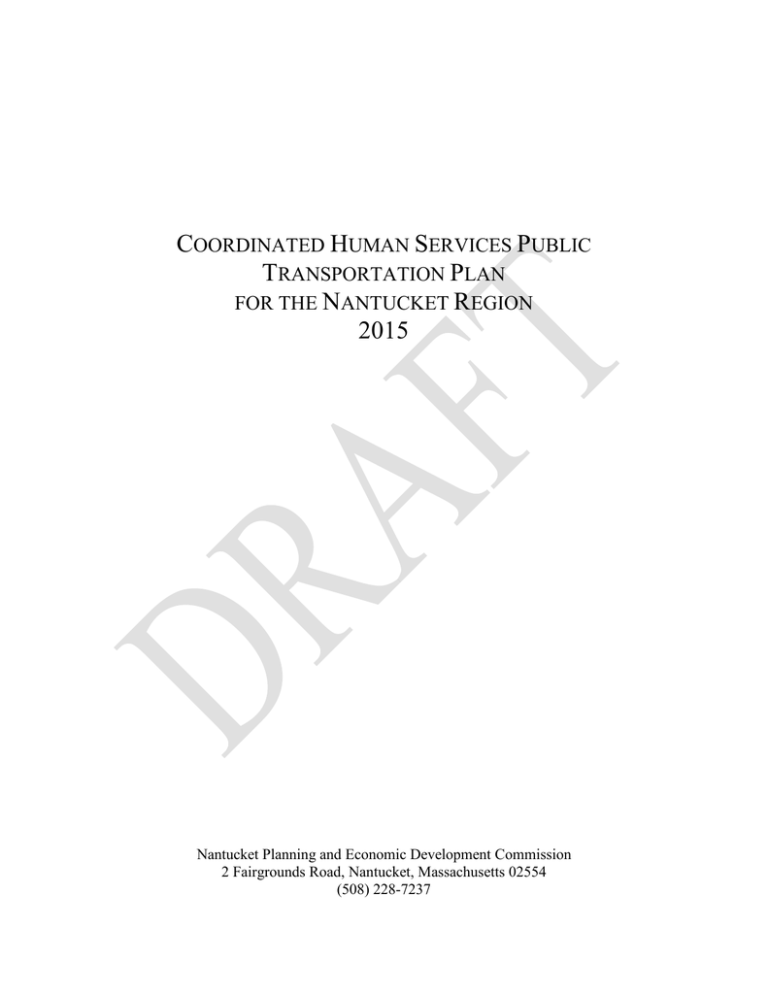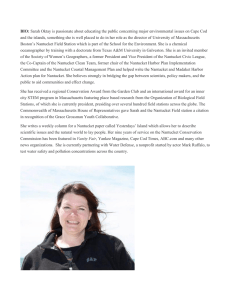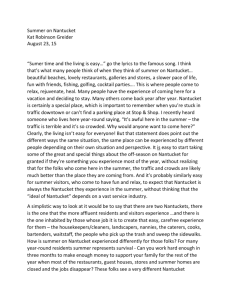C H S P
advertisement

COORDINATED HUMAN SERVICES PUBLIC TRANSPORTATION PLAN FOR THE NANTUCKET REGION 2015 Nantucket Planning and Economic Development Commission 2 Fairgrounds Road, Nantucket, Massachusetts 02554 (508) 228-7237 Summary Federal transportation law requires the development of a Coordinated Human Services Public Transportation plan. This plan is intended to identify needs and gaps in human services transportation for seniors and individuals with disabilities in Nantucket County. The plan will be used to direct Federal Transit Administration funds allocated by MAP-21, specifically 5310 Enhanced Mobility for Seniors and Individuals with Disabilities. All federal section 5310 funding must be consistent and in keeping with the findings, goals, and objectives outlined in this plan. Human service transportation in Nantucket County is available community wide and accommodates seniors 60 years of age and older and all types of disabilities. Compared with the rest of Massachusetts, there is about an average portion of the population who are seniors living in Nantucket County (12.5% locally versus 14.1% statewide) and there are slightly less than average portion of the population with disabilities (8.3% locally versus 11.3% statewide). Since there are individuals who are senior, disabled, or both in the region, improvements will have substantial benefits for those who currently or will use these services. To identify needs, information from the American Community Survey, Nantucket Regional Transit Authority (NRTA), Cape and Islands Regional Coordinating Council, and public comments from a 2012 public outreach campaign by the NRTA were used. Since the NRTA is the only provider of human service transportation, coordination and planning involved in allocating these funds involve consultation between the NRTA and NP&EDC staff, NRTA Advisory Board, and local committees with a mission of identifying and advocating for the needs of the elderly and disabled, such as the Council on Aging, Council for Human Services, Commission on Disabilities, and Elder Services. The identified needs are listed below and align with the goals established in this plan: • • • • • Weekend demand response service Evening demand response service Replacement of demand response vehicles Sidewalks linking fixed route stops to origins/destinations Bus shelters at fixed route stops The application process for Section 5310 funds is facilitated and distributed by Massachusetts Department of Transportation. Applicants for the funds are identified as sub-recipients and should reference the goals identified in this plan when applying for funds. Introduction The purpose of the region’s Coordinated Human Services Public Transportation (CHST) Plan is to identify the transportation needs of individuals with disabilities, older adults, and those with lower incomes, and to identify and prioritize strategies for meeting those needs. The primary reason for this goal is to promote transportation equity among those who may otherwise be transportation disadvantaged. This purpose also supports managing resources efficiently and effectively, and fostering cooperation among agencies and organizations. Seniors and individuals with disabilities often rely on transportation services to perform daily tasks such as medical appointments, jobs, and shopping. The services include year round demand response van service and seasonal fixed route public transportation. The CHST plan is not intended to be prescriptive; instead it will identify needs in service to seniors and individuals with disabilities and establish goals for which funding requests must comply. The plan is mandated and supported by the associated funding program, Enhanced Mobility of Seniors and Individuals with Disabilities (Section 5310) that is established in the federal transportation legislation known as MAP-21 (Moving Ahead for Progress in the 21st Century). Population COMMUNITY PROFILE Nantucket is located 25 miles off the south shore of Cape Cod in Nantucket Sound. The main island of Nantucket is approximately 45.9 square miles, and is 14 miles long and varies in width from 3 to 6 miles. The appeal of the island as a year-round residence is evident in the Island’s increasing population figures. As illustrated in Figure 1, the island’s year-round population increased dramatically during the past few decades. According to the US Census figures, there were 5,087 residents in 1980, and by 2010 this figure had grown to 10,172. Although this level of growth has slowed between 2000 and 2010, the population is still projected to increase in the coming decades. Figure 1. Total Population (US Census) SENIOR DEMOGRAPHIC In Nantucket County, seniors (65+) make up 12.5% of the regional population, which has increased steadily since 1990 (see Figure 2). Although many older people live independently, assisted and independent living facilities are available. Transportation and affordability can be a burden for seniors, but is an important need that allows them to participate in community events and activities, get to medical appointments, lunch programs, shopping, and other activities outside their homes. Figure 2. Age Distribution (US Census and ACS 2009-2013) DISBALED DEMOGRAPHIC The disabled population in Nantucket is made up of all ages. K-12 schools in Nantucket have disability educational programs and supplementary disability transportation services. According to the American Community Survey, the disabled population in Nantucket is 8.3%, which is slightly less than proportional with the statewide disabled population (11.3%). This still shows that there is a demand for transportation services. People with disabilities often rely on public transportation to go about necessary and regular tasks. Expanding human service transportation will allow individuals with disabilities to overcome burdens of limited mobility. Figure 3. Population with a disability (ACS 2009-2013) Ridership and Vehicle Inventory RIDERSHIP TRENDS Ridership data for services provided to elders and individuals with disabilities was provided by the NRTA. Table 1 below shows the total riders in 2013 and 2014 for demand response, human services transportation, and fixed route services. CY 2013 CY 2014 Total Total Ridership Ridership Demand Response Human Service Transportation Fixed Route Total CY 20132014 difference by percent 7,698 6,494 -15.6% 458 546 19.2% 278,426 286,582 289,019 296,059 3.8% 7.4% Table 1. NRTA Ridership The demand response service is an advance reservation door to door van service that is provided year round, Monday through Friday from 8:00 a.m. to 4:00 p.m. Human service transportation is brokered through the Cape Cod Regional Transit Authority and is provided by the NRTA through its demand response service and includes DDS (Department of Developmental Services) transportation and PT1 medical transportation to transport eligible MassHealth members to medical appointments (often requires a doctor’s prescription). All NRTA fixed route vehicles are lift equipped and are in compliance with the American with Disabilities Act. Ridership on the NRTA’s fixed route services comprises many different segments of Nantucket’s population including seniors and individuals with disabilities. FLEET INVENTORY The NRTA has 18 fixed route vehicles equipped with wheelchair lifts and four (4) Ford EcoVans that are utilized to provide its elderly and disabled demand response service. With emphasis being placed on State of Good Repair at the Federal and State levels the NRTA has identified a replacement plan for its vehicles through the 5310/MAP program. The NRTA is a sub-recipient of these funds through MassDOT and the competitive grants process. Below is a description of the NRTA’s fleet of vehicles: Table 2. Fixed Route Vehicles Bus # 1 2 3 4 5 6 7 8 9 10 11 12 13 14 15 16 17 18 Year 2008 2007 2010 2007 2012 2013 2011 2013 2006 2006 2011 2011 2013 2011 2013 2013 2013 2011 Make Eldorado Eldorado IC Eldorado IC IC IC IC Eldorado Eldorado IC IC IC IC IC IC IC IC Model Escort RE Escort HC CB Escort HC CB HC HC CB HC Escort RE Escort RE HC CB HC CB HC TC HC CB HC TC HC TC HC TC HC CB Capacity 29 29 25 29 25 25 25 25 29 29 25 25 25 25 25 25 25 25 Age (years) 7 8 5 8 3 2 4 2 9 9 4 4 2 4 2 2 2 4 Table 3. Demand Response Vehicles Model Year 2003 2003 2009 2009 Make Model Capacity Age (years) Mileage Anticipated Replacement 85,517 FY14* 88,514 FY14* 37,719 FY15 52,155 FY15 *The NRTA submitted and was awarded two van replacements that will replace the 2003 Ford EcoVans. Ford Ford Ford Ford EcoVan EcoVan EcoVan EcoVan 9 9 9 9 12 12 6 6 Stakeholder Coordination REGIONAL COORDINATING COMMITTEES In 2012, Massachusetts Executive Order 530: Community, Social Service, and Paratransit Transportation Commission, formed Regional Coordinating Councils (RCC). The councils were formed to address service gaps locally. The purpose of this body is to facilitate coordination between existing and proposed transportation services. NRTA is a member of the Cape and Islands RCC. The goal is to have state, regional and local agencies work together to build an efficient, cost effective approach to transportation for human service programs and consumers that eliminated duplication of effort and services while better addressing unmet need. ANNUAL PROGRAM OF PROJECT DEVELOPMENT AND APPROVAL PROCESS All funding for services provided by the NRTA are reviewed and approved by the Nantucket Planning and Economic Development Commission (NP&EDC) and appear in the NP&EDC’s annual Transportation Improvement Plan (TIP). This process ensures coordination among the agencies and ensures that funding for services aligns with regional transportation goals. OTHER OUTREACH AND COORDINATION EFFORTS The NRTA and NP&EDC staff meets with a variety of other transportation stakeholders as part of on-going planning and program development. In development of this plan, the local stakeholders that were consulted include: • • • • Council on Aging Council for Human Services Commission on Disabilities Elder Services Assessment of Needs To assess the needs for this plan, a consumer survey administered by the Cape and Islands RCC was evaluated and public comments from an NRTA’s public outreach campaign were also evaluated. A summary of the survey and public comments received are summarized below: CAPE COD AND ISLANDS RCC CONSUMER SURVEY A selection of consumer survey questions, specific to Nantucket, that were beneficial to identifying the needs are presented below. It is important to note that for all questions presented below, organizations could select multiple answers. Question 1: Residential Status Year-Round Seasonal Just Visiting 88.57% 11.43% 0% Question 2: How old are you? Below 18 19-30 31-50 51-60 0% 2.86% 37.14% 20% 61-70 71-80 80+ 11.43% 11.43% 17.14% Question 5: Do you have a medical condition or disability, permanent or temporary that prevents from using public transportation services? No Permanently Disabled Temporary Disabled 62.86% 31.43% 5.71% Question 9: Barriers that impede your ability to access public transportation. Lack of Sidewalks Lack of Curb Cuts Poor Roads Grading Snow or Debris on Sidewalks No Bus Shelter No Crosswalk No Signal Crossings Traffic Heat/Humidity 42.86% 14.29% 0% 14.29% 35.71% 14.29% 7.14% 28.57% 28.57% Question 15: Do you own a car? Yes No 33.33% 66.67% Question 16: What transportation options do you typically use? Drive your own car Driven by family or friend Share rides Nantucket Transit Nantucket Your Island Ride (demand response service) Taxi Council on Aging Services Biking Walking Transportation from an organization 33.33% 39.39% 9.09% 60.61% 36.36% 33.33% 3.03% 18.18% 33.33% 6.06% Question 17: Do you have difficulty paying for transportation services? Yes 25% No 75% Question 18: What are your transportation challenges? Services are not affordable Lack of night service Lack of weekend service Few or no services available I do not know about available services Lack of wheelchair accessible services Loss of drivers license I do not know how to use public transportation Particular locations are difficult to access with public transit Flexibility of transit services 10.34% 34.48% 34.48% 17.24% 13.79% 6.9% 6.9% 17.24% 24.14% 31.03% Question 19: To which destinations do you most often need transportation services? Grocery Store Salon Medical Visit Hospital Day Programs Restaurant Retail Work Entertainment Social Services/Public Assistance Government Services 45.16% 16.13% 45.16% 35.48% 29.03% 16.13% 12.90% 45.16% 29.03% 19.35% 16.13% Question 22: Do you ride the local Transit Authority bus system? Yes No 77.14% 22.86% Question 26: Do you think your area has adequate transportation services? Yes No Not Sure 48.48% 36.36% 15.15% Feedback through consultation with the transportation stakeholder committees by the Nantucket Regional Transit Authority was also used to identify unmet needs. Below is a list of comments received. • • • • • • Sunday service for church More flexibility Weekend service Extend hours of operation into the evenings Provide additional vans More service hours SUMMARY OF SIGNIFICANT NEEDS IDENTIFIED The following list summarizes the needs that were identified in assessment: • • • • • Weekend demand response service Evening demand response service Replacement of demand response vehicles Sidewalks linking fixed route stops to origins/destinations Bus shelters at fixed route stops Plan Goals and Objective The purpose of this plan is the identification of coordinated actions to identify unmet needs in service and establish strategies for more efficient utilization of resources. The followings goals and objectives identify goals for projects related to the assessment of needs. These goals and objectives will provide criteria for the selection of projects using 5310 funds. GOAL 1: PROVIDE SERVICE TO ADDRESS BARRIERS AND UNMET NEEDS FOR SENIORS AND DISABLED COMMUNITIES Objectives: • Provide weekend and evening service • Improve demand response scheduling GOAL 2: IMPROVE INFRASTRUCTURE THAT ALLOWS ACCESS TO PUBLIC TRANSPORTATION Objectives: • Provide safe access on and off vehicles • Provide ADA compliance sidewalks directly on and to bus routes • Provide crosswalks as bus stop locations, as necessary • Provide bus shelters • Remove snow and other debris from sidewalks GOAL 3: PROVIDE CAPITAL EQUIPMENT AT OR ABOVE STATE OF GOOD REPAIR Objectives: • • • Provide and maintain vehicles at or above state of good repair Acquire modern vehicles and technical applications Acquire modern accessible service equipment Conclusion Access to affordable, reliable, safe and timely transportation is an essential component of Federal, State, Regional and Local programs providing employment, medical care and an array of other services for seniors and individuals with disabilities. Expanding these services is essential to accommodation in the described populations. Based on outreach efforts, the identified transportation needs of the elderly and disabled populations are: • • • • • Weekend demand response service Evening demand response service Replacement of demand response vehicles Sidewalks linking fixed route stops to origins/destinations Bus shelters at fixed route stops Applicants for Section 5310 are encouraged to align requests with goals identified in this plan and follow all requirements put forth by the designated recipient, MassDOT, before and after applying. Funds may be used for capital or operating costs. The progress of transportation services will allow them to go about regular tasks, such as visiting the doctor, shopping, attending church services and attending social events, which otherwise they could not do.





